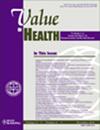机器学习方法在映射研究中比回归模型表现更好吗?系统评价。
IF 4.9
2区 医学
Q1 ECONOMICS
引用次数: 0
摘要
目的:确定如何在映射研究中实施机器学习(ML)方法,以及与回归模型(rm)相比,机器学习在多大程度上提高了性能。方法:系统检索12个数据库从成立到2023年12月的文献,找出应用ML开发映射算法的研究。应用数据模板提取数据集信息、源和目标测度、ML方法和均方根、映射类型(直接与间接)、拟合优度指标(平均绝对误差[MAE]、均方误差[MSE]、均方根误差[RMSE]、r平方和类内相关系数[ICC])以及验证方法。总结ML和RMs在拟合优度指标上的差异。进一步讨论了机器学习的潜在优势和挑战。结果:确定了13个作图研究,其中ML和RM都采用。贝叶斯网络是最常用的ML方法(n=6),其次是最小的绝对收缩和选择算子(n=4)。使用最多的是普通最小二乘模型(n=8),其次是删减最小绝对偏差模型和多项logit模型(各n=5)。与RMs相比,各指标对ML拟合优度的平均改善分别为0.007 (MAE)、0.004 (MSE)、0.058 (r²)、0.016 (ICC)和-0.0004 (RMSE)。结论:使用机器学习开发映射算法的研究越来越多。一般来说,当使用基于均值的比较时,与均方根相比,观察到拟合优度的轻微改善。诸如如何解释、应用和外部验证基于ml的输出等问题将影响它们的实现。未来的研究需要验证机器学习方法的优势。本文章由计算机程序翻译,如有差异,请以英文原文为准。
Do Machine Learning Approaches Perform Better Than Regression Models in Mapping Studies? A Systematic Review
Objectives
To identify how machine learning (ML) approaches were implemented in mapping studies and to determine the extent to which ML improved performance compared with regression models (RMs).
Methods
A systematic literature search was conducted in 12 databases from inception to December 2023 to identify studies that applied ML to develop mapping algorithms. A data template was applied to extract data set information, source and target measures, ML approaches and RMs, mapping types (direct vs indirect), goodness-of-fit indicators (mean absolute error, mean squared error, root mean squared error, R-squared, and intraclass correlation coefficient), and validation methods. Differences in goodness-of-fit indicators between ML and RMs were summarized. Potential advantages and challenges for ML were further discussed.
Results
Thirteen mapping studies were identified, in which both ML and RM were adopted. Bayesian networks were the most frequently used ML approach (n = 6), followed by the least absolute shrinkage and selection operator (n = 4). The ordinary least square model was the most used RM (n = 8), followed by the censored least absolute deviation and multinomial logit models (n = 5 each). The average improvement in the goodness-of-fit of ML compared with that of RMs by indicators were 0.007 (mean absolute error), 0.004 (mean squared error), 0.058 (R-squared), 0.016 (intraclass correlation coefficient), and −0.0004 (root mean squared error).
Conclusions
There is an increasing number of studies using ML in developing mapping algorithms. Generally, a minor improvement of goodness-of-fit was observed compared with RMs when using mean-based comparisons. Issues such as how to interpret, apply, and externally validate the ML-based outputs would affect their implementation. Future studies are warranted to verify advantages of ML approaches.
求助全文
通过发布文献求助,成功后即可免费获取论文全文。
去求助
来源期刊

Value in Health
医学-卫生保健
CiteScore
6.90
自引率
6.70%
发文量
3064
审稿时长
3-8 weeks
期刊介绍:
Value in Health contains original research articles for pharmacoeconomics, health economics, and outcomes research (clinical, economic, and patient-reported outcomes/preference-based research), as well as conceptual and health policy articles that provide valuable information for health care decision-makers as well as the research community. As the official journal of ISPOR, Value in Health provides a forum for researchers, as well as health care decision-makers to translate outcomes research into health care decisions.
 求助内容:
求助内容: 应助结果提醒方式:
应助结果提醒方式:


